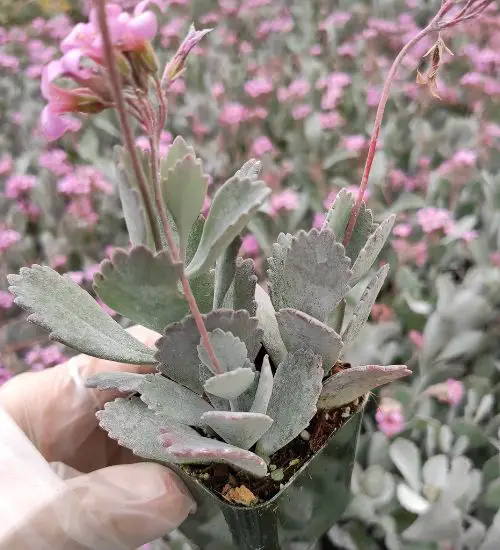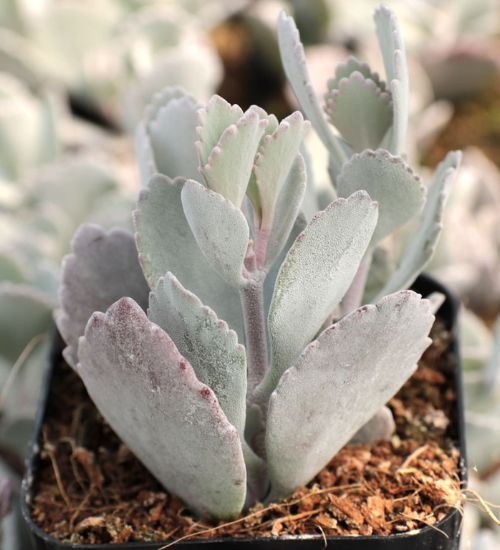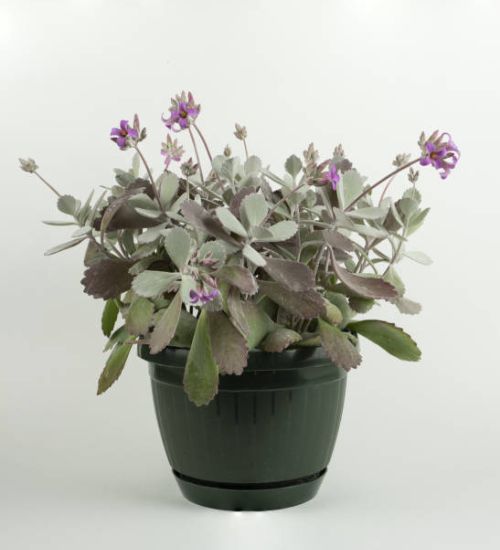Sun: full sun to partial shade
Water: Typical water needs for a succulent
Temperature: Zone 9a from 20° F to 25° F (-6.7 ° C to -3.9° C)
Winter Survival: Not cold hardy
Propagation: leaves, stem cuttings
Flower: in late winter or early spring
Flower Type:
Toxic: Can be toxic to humans and animals
Dormant: summer
Space Requirement: Outdoors
Common Problems: pests
Where to buy Kalanchoe pumila?
Basc Care for Kalanchoe pumila
Watering
Can you water your succulent more than what its need? The answer is yes and no. In extreme conditions, you can water your plants more often when you notice the soil is completely dry.
Fertilizing
Only feed this succulent during its active growing seasons which means spring and fall. Use the right fertilizer applied in the right amounts. Applying half-strength balanced fertilizer every month or so is recommended for optimal results.
Do not fertilize during summer as the plant is dormant.
Sun & Location Requirements for "Flower Dust Plant"
Kalanchoe pumila does best when placed in an area that receives full sun to partial shade throughout the day. This variety of succulents can tolerate direct sunlight for short periods, but if the temperatures get too high or the light is too intense it may be beneficial to find a shadier spot.
As per this succulent profile, it is only able to stay healthy when the environment temperature is above the range of zone 9a from 20° F to 25° F (-6.7 ° C to -3.9° C).
In order to protect Kalanchoe pumila from freezing temperatures, it is important to provide adequate insulation and drainage. A layer of mulch or gravel will help protect the roots by keeping them warm during cold weather. In addition, protection from wind and sun exposure can help reduce the chances of frost damage.
Any succulents in the group will need a large space to grow. You should place your pot outdoor. Since this plant needs a lot of space than other succulents, you should consider not planting them together with other succulents/plants.
Propagation
Propagating succulents by leaves is a great way to grow new plants from existing ones. Simply cut off a few healthy leaves from the mother plant and place them on top of a potting mix. Water the soil regularly, keeping it moist but not soggy, and soon you'll have brand new succulents!
Successfully propagating succulents is a great way to increase your collection of these unique houseplants. To propagate Kalanchoe pumila by stem cuttings, you’ll need a few supplies including a sharp, clean knife and soil.
Toxicity

Kalanchoe pumila has high levels of calcium oxalate, a substance that is toxic to both humans and animals. Ingesting parts of this succulent can cause skin irritation, difficulty breathing, blurred vision and vomiting in severe cases. Keep children and pets away from ""Flower Dust Plant"" and regularly inspect for signs of damage or consumption.
Pests and Diseases
Kalanchoe pumila can be affected common pests and diseases like most of the other succulents such as mealybugs, scale insects, and Red spider mites.
If you do spot any of pest signs, you can treat your succulent using below methods.
- Mealybugs: quarantine, clean infected plants, soapy water.
- Scale insects: quarantine, clean infected plants, soapy water.
- Red spider mites: Quarantine, clean your infected plants, treatment with a systemic insecticidal/soapy water.
Besides that, to prevent serious health issues from happening, keep your succulent in a well-ventilated area and check it regularly for any signs of pests or health problems.


